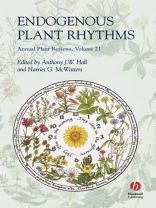Our knowledge of the circadian clock in plants has advanced
considerably in recent years and we now have a clearer view of the
biochemical processes making up its mechanism. Recent work provides
insight into the central role played by the circadian system in the
regulation of many aspects of metabolism. The multiple systems
involved in photoreception have been determined, leading to an
understanding of how light entrains the internal biological clock
to the natural cycle of day and night, and how this impacts on key
events in the plant lifecycle, such as the photoperiodic regulation
of flowering.
This book provides a contemporary overview of endogenous plant
rhythms for researchers and professionals in the plant sciences. It
will also serve as a valuable source of reference for the wider
circadian community.
Зміст
1. The plant circadian clock: review of a clockwork
Arabidopsis.
Frank Harmon, Takato Imaizumi and Steve Kay, Department of Cell
Biology, The Scripps Research Institute, La Jolla, California,
USA.
2. Pseudo-response regulator genes’tell’ the time of day:
multiple feedbacks in the circadian system of higher
plants?.
Shiregu Hanano and Seth Davis, Department of Plant Developmental
Biology, Max Planck Institute for Plant Breeding Research, Cologne,
Germany.
3. Multiple and slave oscillators.
Dorothee Staiger and Corinna Streitner, Institut für
Pflanzenwissenschaften, ETH, Zurich, Switzerland, and.
Fabian Rudolf, Institut für Biochemie, ETH, Zurich,
Switzerland, and.
Xi Huang, Institut für Pflanzenwissenschaften, ETH, Zurich,
Switzerland.
4. Entrainment of the plant circadian clock.
David Somers, Ohio State University, Columbus, Ohio, USA.
5. Photoreceptors and light signalling pathways in
plants.
Victoria Larner, Keara Franklin and Garry Whitelam, Department
of Biology, University of Leicester, UK.
6. Circadian regulation of global gene expression and
metabolism.
Stacey Harmer and Michael Covington, Section of Plant Biology,
University of California, Davis, California, USA, and.
Oliver Bläsing and Mark Stitt, Max Planck Institute of
Molecular Plant Physiology, Potsdam, Germany.
7. Photoperiodic responses and the regulation of
flowering.
Isabelle Carré, Department of Biological Sciences,
University of Warwick, Coventry, UK, and.
George Coupland, Max Planck Institute for Plant Breeding
Research, Cologne, Germany, and.
Joanne Putterill, School of Biological Sciences, University of
Auckland, New Zealand.
8. Circadian regulation of Ca2+ signalling.
Michael Gardner, Antony Dodd and Carlos Hotta, Department of
Plant Sciences, University of Cambridge, UK, and.
Dale Sanders, The Plant Laboratory, Biology Department,
University of York, UK, and Alex Webb, Department of Plant
Sciences, University of Cambridge, UK.
9. The circadian clock in CAM plants.
James Hartwell, Centre for Novel Agricultural Products,
Department of Biology, University of York, UK.
10. Clock evolution and adaptation: whence and
whither?.
Carl H Johnson, Department of Biological Sciences, Vanderbilt
University, Nashville Tennessee, USA, and.
Charalambos Kyriacou, Department of Genetics, University of
Leicester, UK
Про автора
Dr Anthony Hall, School of Biological Sciences, University of
Liverpool, UK.
Dr Harriet Mc Watters, Department of Plant Sciences, University of
Oxford, UK












